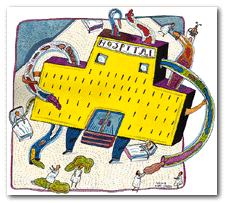Main Menu · Search · Current Issue · Contact · Archives · Centennial · Letters to the Editor · FAQs
![]()
Main Menu · Search · Current Issue · Contact · Archives · Centennial · Letters to the Editor · FAQs

| Gone Fission | High Flying |
| Harvard Men as Alcoholics | Bacterial Revenge |
| The Fall of the House of Ashes? | Cuisine Before Forks |
| E-mail and Web Information | |

![]()
Can going to the hospital make you sicker? The answer, unfortunately, is yes, says Jonathan Freeman '61, S.D. '82, assistant professor of medicine and assistant professor in the department of epidemiology at the School of Public Health.
"On average, about 5 percent of hospital patients in this country acquire infections that were not present or incubating on admission," he explains. Some infections are unavoidable because the host's defenses have been destroyed due to underlying disease or to treatment with immunosuppressive medications (as in the case of transplants). In addition, Freeman says, "We're keeping people alive longer now, using supportive technologies that weren't possible before. In other eras, people died from the underlying illness. Now they live longer, but they're vulnerable to infections."
These hospital-acquired, or "nosocomial," infections-from the Greek words nosos ("disease") and komein ("to care for")-often gain access to the body through the very tubes and catheters used to save a patient's life. The most common are urinary tract infections (UTIs), caused by bladder catheters. UTIs are uncomfortable but not life-threatening. Pneumonias, however, also occur frequently, and they can kill. They enter through tubes put in the trachea when a patient requires a ventilator. Intravenous lines (IVs) provide gateways for other opportunistic infections to enter veins and arteries.
A patient can be vulnerable in multiple ways. "Let's say there's a car wreck," Freeman explains. "The victim is rushed into the emergency room, and within five minutes is all hooked up. They'll have an endotrachial tube, be on a ventilator, have IVs in them. They'll have a bladder catheter. And they'll live. But these tubes and catheters provide organisms a direct route into the body, bypassing the nose and all the body's other defenses."
Because patients afflicted by nosocomial infections already suffer from other medical problems, it's hard to judge when the infections are the cause of death. The National Academy of Sciences' Institute of Medicine gives a figure of 20,000 deaths annually out of a total of 2 million people with hospital-acquired infections-a 1 percent mortality rate, with pneumonias responsible for most of the deaths.
Although most nosocomial infections are not lethal, they are expensive, prolonging hospital stays an average of 10 days. The estimated cost of the additional hospital time is $5 to $10 billion each year-most of which insurance carriers will not cover, forcing the individual medical facilities to bear the loss.
The study of hospital-acquired infections goes back 150 years, to the work of Hungarian physician Ignaz Semmelweis. As an assistant in the maternity department of the Allegemeines Krankenhaus in Vienna, Semmelweis noticed an appreciable difference between the maternal death rates in the hospital's two divisions. In the next few years, he analyzed patient deaths and medical practices, arriving at the conclusion that the doctors themselves were spreading contagion. He shocked the Viennese medical community by suggesting that physicians clean their hands between patients.
In many respects, according to Freeman, little has changed: bedside sinks and handwashing are still imperative. "Most important nosocomial pathogens are carried on the hands of medical personnel," he says. "These organisms will not affect a healthy person, but they can be deadly to an immunocompromised individual. For instance, chicken pox may be annoying and uncomfortable to the average child, but it'll wreak havoc on a kid with leukemia who already has a weakened defense system. Then there are the strains of bacteria that are particularly resistant to antibiotics: it's like the Darwinian evolution of microbes in the hospital. Because so many drugs are used, only the strongest bacteria survive. When they infect a patient, treatment is more difficult."
Freeman has just completed a 20-year study in which he surveyed Boston-area hospitals to determine the incidence of nosocomial infection and the factors that contribute to it. He interviewed every patient himself because, he says, "I wanted to make sure it was done right." "Nosocomial infections are diseases of medical progress," Freeman explains. "They're about the things that we do to people, the choices that we make. I'm trying to define what proportion of infections are preventable."
M.E.M
Main Menu · Search · Current Issue · Contact · Archives · Centennial · Letters to the Editor · FAQs
![]()
Harvard Magazine · 7 Ware Street · Cambridge, MA 02138 · Phone (617) 495-5746